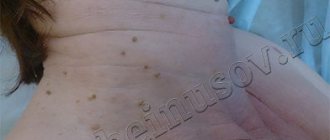Papillomas are areas of pathological proliferation of cells in the upper layer of the skin and mucous membrane. Over time, these benign tumors can become a source of cancer, so many patients are concerned with the question: how to get rid of papillomas. Let's figure out why papillomas occur on the body, why they are dangerous to health, and whether they need to be removed.
Appointment with a dermatologist - 1000 rubles. Removing papilloma using the best method - radio knife - 500 rubles. Consultation with a specialized doctor based on the results of ultrasound and tests - 500 rubles. (optional).
What happens if you tear off a papilloma on a leg?
When a pedunculated papilloma is detached from the base, the benign neoplasm begins to become inflamed.
This creates a wound surface.
All this is accompanied by itching and increased body temperature.
There is suppuration and swelling due to the inflammatory reaction.
Remains of papilloma must be removed in a hospital setting.
Such injuries threaten the degeneration of a benign papilloma into a malignant neoplasm.
Sometimes, with good immunity, papillomas come off and new ones do not grow.
There is no negative impact.
The recovery is complete.
Symptoms and location
Papillomas can appear all over the body, but areas with delicate skin are considered the most common. Depending on the location of the formations, experts distinguish:
- Papillomas on the neck, which are considered the most dangerous. They are often injured by clothes and chains, and in the summer they are exposed to direct ultraviolet radiation. Violation of the integrity of the papilloma leads to infection of surrounding tissues. In this case, you should not postpone your visit to the doctor. Hanging papillomas on the neck should be removed.
- Papillomas under the armpit cause severe discomfort. Such formations require constant monitoring due to the large number of sweat glands. As a result, a favorable environment is formed for the development of pathogenic microorganisms. There is a high risk of melanoma formation.
- Papillomas in the groin area and under the mammary glands in women are not as dangerous as other types. Cosmetic defects in these areas are removed extremely rarely. Can cause discomfort during epilation and shaving of the bikini area.
- Papillomas on the face can most often be seen in the eyelid area or near the lips. A cosmetic flaw traumatizes the psyche, especially women. First, a small lump appears on the skin, similar to a pimple. Gradually it increases in size. Large formations on the eyelids lead to changes in vision, interfere with washing, and also interfere with sleep.
- Papillomas in the mouth and nasopharynx are rare. Usually these are small formations no more than 1 cm in length.
The color of the growth can completely match the skin tone, be lighter or darker. An alarming symptom in the presence of hanging papillomas is an increase in size, darkening, bleeding, pain, redness, swelling and unbearable itching.
Why can our articles be trusted?
We make health information clear, accessible and relevant.
- All articles are checked by practicing doctors.
- We take scientific literature and the latest research as a basis.
- We publish detailed articles that answer all questions.
If such manifestations occur, you should urgently consult a dermatologist.
How to distinguish a papilloma from a mole
The papilloma is colorless and pedunculated.
A nevus or wart does not have a stalk and is brown in color.
It is advisable to remove papillomas, since they are most often located in areas of increased trauma and are not very aesthetic.
As a rule, moles do not pose any danger.
They do not have a special function and in their structure contain various pigments in large quantities.
Pedicled papilloma: diagnosis, histology
Pedicled papillomas, like other papillomas, must be subjected to histological examination.
This will complement the cytological examination.
The histological examination method consists of analyzing a biopsy specimen - a part of the papilloma obtained during its removal.
A microscope is used for this.
We evaluate the nature of the benign tumor and determine the degree of oncogenicity of the papilloma.
Within three days after the study, we have the result.
The diagnosis of papillomatosis when infected with HPV occurs on the basis of laboratory diagnostics:
- cytological analysis (to determine changes in the cellular material of the test sample);
- carrying out a polymerase chain reaction (to find viral DNA in the material under study);
- obtaining a biopsy specimen for histological examination;
- carrying out the histological examination itself;
- conducting a daijin test.
The Daijin test is carried out to determine the type of HPV, its quantity and degree of oncogenicity.
Without laboratory research methods, based only on the clinical picture, even an experienced doctor has difficulty in making a correct and accurate diagnosis.
Complications of papillomas
The most important complication is the degeneration of benign neoplasms into malignant tumors.
It is necessary to determine as quickly as possible the type of HPV that caused the formation of papillomas.
If it is a highly oncogenic type 16 or 18, constantly monitor the development and changes in the condition of papillomas.
These pedunculated papillomas also threaten traumatization and relapse.
You should always remember this and avoid injury, and after removing papillomas, prevent their occurrence.
Hanging warts: treatment
The treatment of warts under the arms must be entrusted to a professional doctor, since self-removal or taking medications may not only not give the expected result, but also significantly harm the patient. The treatment procedure for hanging warts usually involves three stages:
- Removal of the body and root of the tumor: laser destruction, radio wave excision, electrocoagulation, cryodestruction or surgical removal;
- Antiviral therapy;
- Restoration of immune function – immunomodulation or stimulation;
- The most important step in the treatment of warts under the arms is the procedure for removing the skin growth. Today, the optimal way to get rid of a tumor in the armpit is laser correction of the defect .
You can find out more about the service and its cost here >>
Degeneration of papillomas into malignant pathology
We must always remember that HPV poses a risk of cancer.
Especially highly oncogenic types, for example, 16 and 18.
Typically, malignant degeneration of papillomas cells takes ten to twenty years from the moment of infection.
The process is accelerated by smoking, drinking alcohol, obesity and hormonal disorders that reduce immunity.
It is the decrease in immunity, which occurs for various reasons, that contributes to the activation of HPV and the transition of the benign state of papillomas to a malignant pathology.
The destruction of papillomas is enhanced by cytomegalovirus, genital herpes, chlamydia, syphilis, gonorrhea, and trichomoniasis.
And of course, you need to avoid frequent trauma to papillomas, which contributes to their malignancy.
A direct indication for removal of papillomas is the presence of large papillomas.
They are often hurt and hurt.
Methods for removing papillomas
There are quite a lot of methods for removing papillomas.
Let's consider everything.
Firstly, it is the destruction of papillomas using a special liquid containing alkali.
They are purchased in pharmacies with prescriptions from the attending physician.
The disadvantage is considered:
- the need for precise local application of liquid to papillomas,
- risk of chemical burns to adjacent tissues,
- painful procedure,
- the possibility of scars appearing at the site of papillomas removal.
Usually, the method is used to remove single vulgar papillomas (warts) of the hands.
It is not suitable for filamentous papillomas.
Refrigerants are used for cryodestruction.
Basically, liquid nitrogen is used.
Although other refrigerants are possible.
The application of the coolant is painless; acute pain occurs later when “defrosting” occurs.
After a certain time, the surrounding tissues turn red and swell.
There is an active formation of a subcutaneous bladder filled with fluid.
After a week (maximum one and a half months), everything heals and is restored.
It takes three weeks for the tissue under the crust to die, while the infected tissue is reliably destroyed.
There are no scars, and any traces disappear within six months.
The intimate area and face are not treated with this method.
Firstly, the genital area is very sensitive.
And secondly, it is not suitable for the face due to post-operative swelling and redness of the surrounding tissues.
Using a special device, papillomas are removed using radio wave coagulation.
Most often they use Surgitron.
The method does not cause pain.
Several radioknives in the kit allow you to choose the most convenient one for papilloma of a given location.
The radioknife provides directed high-frequency radiation, which cuts off the papilloma, “evaporating” its tissue.
There is no rehabilitation period.
The operation is quick, painless and leaves no traces of the intervention.
But if there are acute inflammatory processes or worsened chronic ones, then radio wave coagulation is not used.
Diabetes mellitus, pregnancy, lactation and any cancer pathology in the body are also contraindications for using the method.
But if there are no contraindications, the method can be successfully used anywhere.
Patients say that the only drawback of the method is the discomfort at the time of administration of the anesthetic.
Laser beams are also used to remove papillomas without contact.
Healthy tissues are not damaged.
Infected papilloma tissues seem to “evaporate” under the action of a laser beam.
A session of laser removal of papillomas does not take long, just a few minutes.
Complete rehabilitation takes place in two weeks.
Side effects include prolonged redness of the skin and swelling of adjacent tissues.
Problems with the thyroid gland contribute to the formation of keloid scars.
Contraindications for the use of laser coagulation are the presence of:
- diabetes mellitus;
- acute inflammatory processes;
- epilepsy;
- disorders of endocrine and immune status;
- photoderomatosis;
- thrombocytopenia.
Patients who have undergone laser coagulation report pain and an unpleasant “burnt meat” smell.
Long-term rehabilitation, pain and tendency to relapse with this method.
Small papillomas are removed by electrocoagulation or cauterization.
Rehabilitation takes place within a week.
Reliable and inexpensive method.
Any localization of papillomas is suitable for its use.
To remove large papillomas or malignant neoplasms, a scalpel is used.
Causes of the disease
The cause of hanging growths is the papillomavirus, the carrier of which is considered to be 90% of the adult population and most children. Infection occurs through household contact. The papilloma virus remains viable on things and objects for 3 hours.
Removing warts with nitrogen
Cryodestruction is a method of removing warts by exposing them to liquid nitrogen.
The following factors can provoke the growth of hanging growths:
- diseases of the gastrointestinal tract, endocrine system;
- weakened immunity;
- alcohol abuse , smoking;
- long-term use of oral contraceptives and other medications, hormonal imbalance in the body;
- increased sweating, uncleanliness;
- constant emotional tension, stress, psychological instability;
- adolescence ;
- unbalanced or insufficient nutrition, consumption of junk food;
- pregnancy;
- promiscuous sex life, frequent change of partners;
- improper treatment of influenza;
- increased weight ;
- sudden change in climatic conditions.
Hanging papillomas can form at any age when favorable conditions arise both inside and outside the body. Percutaneous infection occurs with any damage to the skin.
The opinion that papillomas are associated with approaching old age is completely erroneous. Young children can also become infected with HPV during fetal development or during childbirth.











